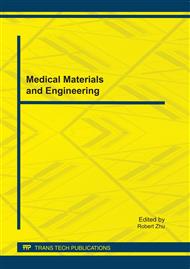[1]
The committee of drug standard of the ministry of public health of the people's republic of china, Drug standard of the ministry of public health of the people's republic of china, The people's medical publishing house, BeiJing, (2010).
Google Scholar
[2]
Nanjing medicine college, Chinese Herbal Medicine Pharmacology, Nanjing medicine college, China, (1980).
Google Scholar
[3]
N.E. Bobryshev, Corn a medicinal plant, Kukuruza. 9 (1962) 59-60.
Google Scholar
[4]
Hanping, Li Haixi, Hou Changxi, Chemical composition of maize silk and the progress in the research of its application, Modern Agricultural Sciences and Technology. 18 (2009) 17-18.
Google Scholar
[5]
C. Nozzolillo, L. Reid, Anthocyanin pigmentation of maize silk, Bull Liaison Groupe Poly. Phenols. 16 (1992) 187-188.
Google Scholar
[6]
Liwei, Research about Maize Silk in Reducing Blood Sugar, Chinese Traditional and Herbal Drugs. 26 (1995) 305-306.
Google Scholar
[7]
Liwei, Research about Glucobest in Reducing Blood Sugar, Journal of Medical Science Yanbian University. 19 (1996) 215-217.
Google Scholar
[8]
Liuqiang, Activity of Reducing Blood Sugar in Model Mice of Diabetes Mellitus, Chinese Traditional and Herbal Drugs. 6 (1997) 379-380.
Google Scholar
[9]
Mahong, Gao Lincong, The Antitumous Activity of Maize Silk Extracts, Journal of Nanjing University of Traditional Chinese Medicine. 1 (1998) 28-32.
Google Scholar
[10]
Zhou Youtian, Chen Yushuai, Mao Xiaojie, Preliminary Study on Antimicrobial Activities of Maize Silk, Journal of Gannan Medical University. 28 (2008) 477-488.
Google Scholar
[11]
JI Lilian, TAN Renxiang. Antimicrobial Activities of Maize Silk Extracts against Food Spoilage and Food-borne Pathogens, Life Science Research. 5 (2001) 68-72.
Google Scholar
[12]
Du Simiao, Ma Liqiang, Sun Junxie, Antimicrobial Activities of Radix Sophorae Flavescentis Extracts, Acta Chinese Medicine and Pharmacology. 38 (2010) 74-76.
Google Scholar
[13]
Liduan, Zhou Ligang, Wang Jinguo, The Inhibitional Effect of Sophora Alopecuroide Extracts of the Pathogenic Bacteria of Cucumbers and Tomatoes, Acta Botanica Boreali-Occidentalia Sinica. 26 (2006) 558-563.
Google Scholar
[14]
Zhang Miaozhi, Tian Zhaofeng, Liu Jialei, The Inhibitional Effect of Eupatorium Adenophorum Extract to Plant Pathogenic Fungi, Journal of Anhui Agricultural Sciences. 38 (2010) 6090-6091.
Google Scholar
[15]
Tangjing, Zhou Ligang, Zhou Yangmin, The Inhibitional Effect of Golden Cypress Extract to Plant Pathogenic Fungi, Natural Product Research and Development. 20 (2008) 505-507.
Google Scholar
[16]
Guo Qiaosheng, Li Yuchuan, Shao Qingsong, The Inhibitional Effect of Jatropha Curcas Extract to Plant Pathogenic Fungi, Bulletin of Botanical Research. 30 (2010) 503-507.
Google Scholar
[17]
A.W. Bauer, W.M.M. Kirby, J.C. Sherries, M. Tuck, Antibiotic Susceptibility Testing by A Standardized Disc method, Am. J. Clin. Pathol. 45 (1966) 493–496.
Google Scholar
[18]
A. Marmonier, Bacte ´riologie me ´dicale, Techniques usuelles, in: Antibiotiques, Technique de diffusion en ge ´lose me ´thode des disques, SIMEP SA-PARIS, France, 1987, p.238–244.
Google Scholar
[19]
HUANG Suo-yi, TANG Yu-lian, LI Hai-ni, The Total Flavanone of Longan Seed Extraction and the Identification by Ethanol, Li Shi Zhen Medicine and Materiamedica Resarch. 18 (2007) 1021-1023.
Google Scholar
[20]
Zhao Liang-zhong, Wang Fang-yin, De Lin-dong, The Study on Antiseptic of the Extract and Antimicrobial Action from Cloyodendron cvrtophyuan, Food Science Research. 25 (2004) 138-140.
Google Scholar
[21]
WangWei, Wu Nan, Fu YuJie, Antimicrobial Activities of Mentha Haplocalyx Briq. Essential Oil, Bulletn of Botanical Research. 27 (2007) 626-629.
Google Scholar
[22]
Liu Shihui, Zhao Degang, Effect of Eucommia Antifungal Peptide against Aspergillus Flavus, Nat Prod Res Dev. 20 (2008) 332-334.
Google Scholar
[23]
D.A. Vanden Berghe, A.J. Vlietinck, Screening methods for antibacterial and antiviral agents from higher plants, in: P.M. Dey, J.B. Harbone, K. Hostettman (Eds. ), Methods in plant biochemistry. Assays for Bioactivity, Academic Press, London, 1991, p.47.
Google Scholar
[24]
S. Burt, Essential oils: their antibacterial properties and potential applications in foods: a review, Int J Food Microbiol. 94 (2004) 223–253.
DOI: 10.1016/j.ijfoodmicro.2004.03.022
Google Scholar
[25]
J. May, C.H. Chan, A. King, L. Williams, G.L. French, Time-kill studies of tea tree oils on clinical isolates, J Antimicrob Chemoth. 45 (2000) 639–643.
DOI: 10.1093/jac/45.5.639
Google Scholar
[26]
P.J. Delaquis, K. Stanich, B. Girard, G. Mazza, Antimicrobial activity of individual and mixed fractions of dill, cilantro, coriander and eucalyptus essential oils, Int J Food Microbiol. 74 (2002) 101–109.
DOI: 10.1016/s0168-1605(01)00734-6
Google Scholar
[27]
A.J. Vlietinck, L. van Hoof, J. Totte et al, Screening of hundred Rwandese medicinal plants for antimicrobial and antiviral properties, J Etyhnopharmacol. 46 (1995) 31-47.
DOI: 10.1016/0378-8741(95)01226-4
Google Scholar
[28]
T. Rabe, J. Van Staden, Antibacterial activity of South African plants used for medicinal purposes, J Ethnopharmacol. 56 (1997) 81-87.
DOI: 10.1016/s0378-8741(96)01515-2
Google Scholar
[29]
C.M. Marjorie, Plant products as antimicrobial agents, Clin Microbiol Rev. 12 (1999) 564-582.
Google Scholar
[30]
A. Smith-Palmer, J. Stewart, L. Fyfe, Antimicrobial properties of plant essential oils and essences against five important food-borne pathogens, Lett Appl Microbiol. 26 (1998) 118–122.
DOI: 10.1046/j.1472-765x.1998.00303.x
Google Scholar
[31]
A. Ultee, E.P.W. Kets, E.J. Smid, Mechanisms of actions of carvacrol on the food-borne pathogen Bacillus cereus, Appl Environ Microbiol. 65 (1999) 4606–4610.
DOI: 10.1128/aem.65.10.4606-4610.1999
Google Scholar
[32]
S.D. Cox, C.M. Mann, J.L. Markham, H.C. Bell, J.E. Gustafson, The mode of antimicrobial action of the essential oil from Malaleuca alternifolia (tea tree oil), J Appl Bacteriol. 88 (2000) 170–175.
DOI: 10.1046/j.1365-2672.2000.00943.x
Google Scholar
[33]
Huang Xiaokun et al, Study on the Extraction and Antibacterial Activity in Vitro of Flavonoids from Syzygium buxifolium Leaves, Journal of Anhui Agri. Sci. 36 (2008) 5257-5258.
Google Scholar
[34]
Wang Yuling, Zhang Yan, Fang Min et al, Anti-inflammatory and antibacterial effects of total flavones of oldenlandia diffusa willd, Chinese Pharmacological Bullet. 21 (2005) 348-350.
Google Scholar
[35]
E. Augustin, Prenylated is of lavanone from the roots of erythrina sigmoidea, Phyochemistry. 35 (1994) 1074-1075.
Google Scholar
[36]
M.L. Hayes, B.K. Berkovitz, The reduction of fissure caries in Wistar rats by a soluble salt of nonanoinic acid, Arch. Oral. Biol. 24 (1979) 663-666.
DOI: 10.1016/0003-9969(79)90115-8
Google Scholar
[37]
J.J. Kabara, D.M. Swieczkowski, A.J. Conley, J.P. Truant, Fatty acids and derivatives as antimicrobial agents, Antimicrobial Agents and Chemother. 2 (1972) 23-28.
DOI: 10.1128/aac.2.1.23
Google Scholar


